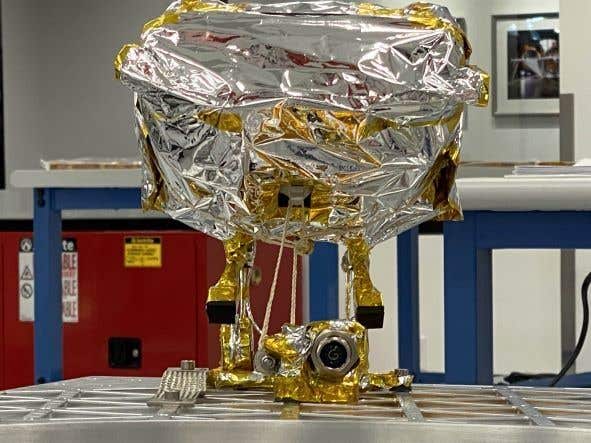COLMENA Project: Tiny robots made in Mexico set to explore the moon
The mission, which will land on the moon next June, is made up of five small robots that will be placed on the lunar surface.

[Feb 27, 2022: Joshua Shavit, The Brighter Side of News]
The mission, which will land on the moon next June, is made up of five small robots that will be placed on the lunar surface. (CREDIT: UNAM)
COLMENA Project, the first joint Mexican and UNAM lunar exploration mission was launched today, with the support of the Ministry of Foreign Affairs (SRE), the Mexican Space Agency, and the state of Hidalgo.
The mission, which will land on the moon next June, is made up of five small robots that will be placed on the lunar surface, which are already installed on the Peregrine spacecraft, of the U.S. company Astrobotic, and ready to travel the 384,400 kilometers that separate the Earth from our natural satellite.
During the presentation of the mission, Rector Enrique Graue Wiechers expressed that this is a celebration ceremony because it shows the strength of the National University and its research institutes, as well as the advances obtained by the Space Instrumentation Laboratory (LINX), with the participation of 200 students who apply basic science to transform reality.
COLMENA Project scientist at work. (CREDIT: UNAM)
Related Stories
"We will be brief to be able to resolve, in the following months, the departure to space of these devices and we will have to celebrate, in June, their launching and, subsequently, their arrival," said Graue Wiechers at the event held at the Rectory Tower of the National University.
COLMENA Project robots will work in a coordinated manner to demonstrate that they can be explorers. (CREDIT: UNAM)
In his speech, the Secretary of Foreign Affairs, Marcelo Ebrard Casaubon, pointed out that "the function of the Foreign Ministry is to support Mexico's relevant scientific projects, that is our task, and in the case of space we have given it a high level of priority in Mexico's foreign policy".
Omar Fayad Meneses, Governor of the State of Hidalgo, affirmed that the mission of this project defines one of the priorities for the future and the participating institutions understand the unique moment in the world space sector, of which Mexico must be a part.
"COLMENA highlights all the values of UNAM and gives Mexican society a new way of seeing and understanding the modern world, the confidence that things are possible and that we can overcome our limits. It will become a milestone and when it happens, next June, it is something that the children and youth of Mexico will know. Maybe it will be what inspires the next astronaut or the leader of the next missions," he said.
The head of LINX, from the Institute of Nuclear Sciences (ICN) of the UNAM, Gustavo Medina Tanco, explained that there is a great transformation of what is known as Space 4.0 and COLMENA is part of it as an internationally original mission; it is the first stage of a space technology niche to be developed for Mexico to be a producer of goods, wealth, knowledge and welfare.
The mission proposes that robots act autonomously and, taking nature as an example, demonstrate that in a coordinated way they can be the explorers and miners of space. It is a set of five robots, each weighing less than 60 grams, 12 centimeters in diameter, and with all their electronics less than two centimeters from the surface of the regolith. It is a challenge of international technology; it is the first time it has been done and it is being done by Mexico and UNAM.
For his part, the Director-General of the Mexican Space Agency, Salvador Landeros Ayala, emphasized that the COLMENA project confirms that Mexican engineering is at the level of the best in the world, since it will be the first Mexican project on lunar exploration, and said that work is already underway on new projects to generate oxygen and energy on the Moon, all with Mexican technology.
Meanwhile, the director of ICN, María del Pilar Carreón Castro, highlighted the efforts of Medina Tanco and the students to achieve a common good. They are examples of how, thanks to basic science, large-scale projects can be achieved, and expressed commitment to support initiatives that position the Institute, UNAM, and Mexico.



COLMENA Project robots will work in a coordinated manner to demonstrate that they can be explorers. The full project team image on the right. (CREDIT: UNAM)
"No one has done this, nobody, not just in Mexico," Medina Tanco said.
"We can make a difference in the technology and for international cooperation that can then lead to important joint ventures to study the minerals or undertake other scientific exploration."
On behalf of UNAM, the Secretary-General, Leonardo Lomelí Vanegas, and the Coordinator of Scientific Research, William Lee Alardín, among others, also participated. Mexico's ambassador to the Latin American and Caribbean Space Agency, Gustavo Alfonso Cabrera Rodríguez, was also present.
Note: Materials provided above by The Brighter Side of News. Content may be edited for style and length.
Like these kind of feel good stories? Get the Brighter Side of News' newsletter.
Tags: #New_Innovations, #Space, #Space_Travel, #Moon, #Technology, #Lunar_Landers, #Science, #Research, #The_Brighter_Side_of_News
Joseph Shavit
Head Science News Writer | Communicating Innovation & Discovery
Based in Los Angeles, Joseph Shavit is an accomplished science journalist, head science news writer and co-founder at The Brighter Side of News, where he translates cutting-edge discoveries into compelling stories for a broad audience. With a strong background spanning science, business, product management, media leadership, and entrepreneurship, Joseph brings a unique perspective to science communication. His expertise allows him to uncover the intersection of technological advancements and market potential, shedding light on how groundbreaking research evolves into transformative products and industries.



